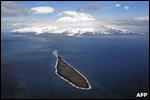- Government
- Posted
Irish Kyoto target forecasts out of date, says Cuffe

NEW PROJECTIONS for Ireland’s Kyoto targets published barely a fortnight ago may already be out of date, Green Party TD Ciaran Cuffe has said.
NEW PROJECTIONS for Ireland’s Kyoto targets published barely a fortnight ago may already be out of date, Green Party TD Ciaran Cuffe has said.
The Environmental Protection Agency’s projection, published on March 12th, relied on new economic research that showed Ireland’s carbon emissions will markedly decrease because of the dramatic downturn.
The “economic shock” scenario was prepared by the Economic and Social Research Institute (ESRI) and showed that, because of the downturn, carbon emissions may be only 1.3 million tonnes above Ireland’s annual 62.8 million tonnes annual target if all the Government’s policies are implemented. Only last year, the EPA predicted that annual emissions would be as much as 3.6 million tonnes above target.
But yesterday Mr Cuffe said the “economic shock” scenario prepared by the ESRI was already out of date and conservative. He said the analysis was prepared in January and estimated there would be a cumulative decrease of 7 per cent in gross domestic product (GDP) between 2008 and 2010.
“We will have a fall of 7 per cent in GDP in 2009 alone,” said Mr Cuffe, “which means that it’s a conservative estimate.”
Mr Cuffe was speaking after a meeting of the Oireachtas Committee on Climate Change and Energy, at which a delegation from the EPA briefed TDs and Senators on its latest projections for Kyoto, and also for the EU’s carbon target, which requires a 20 per cent reduction in greenhouse gas emissions by 2020.
Dr Eimear Cotter of the EPA agreed the economic situation had changed since the ESRI research in January.
“The latest figures would have to be looked at again to see if it reflects the latest forecast. The [economic] situation is changing so rapidly that it’s hard to keep up with it,” she said.
Dr Cotter, and her colleagues EPA director Laura Burke and Dr Ken Macken, appeared before the committee to present the latest projections.
In relation to the new EU target that requires a 20 per cent reduction in emissions by 2020, the EPA estimates that with additional measures, and taking the “economic shock” scenario into account, Ireland will miss its target by 2.7 million tonnes.
However, that figure relies on Ireland using carbon sinks, including afforestation. Dr Macken told the committee that the Irish Government has lobbied strongly for carbon sinks to be included. He said that while it was highly likely they would be included, it would be determined with certainty by the outcome of the global talks on climate change in Copenhagen later this year.
Questioned by several committee members, the EPA officials said only Government policy that has been agreed but not implemented was included in additional measures. Dr Cotter instanced the commitment that 33 per cent of the State’s energy needs will come from renewable sources in that period.
Other proposals, such as 10 per cent of cars being powered electrically and a carbon tax, have yet to be factored in. Both have the potential to further reduce emissions.
The Environmental Protection Agency’s projection, published on March 12th, relied on new economic research that showed Ireland’s carbon emissions will markedly decrease because of the dramatic downturn.
The “economic shock” scenario was prepared by the Economic and Social Research Institute (ESRI) and showed that, because of the downturn, carbon emissions may be only 1.3 million tonnes above Ireland’s annual 62.8 million tonnes annual target if all the Government’s policies are implemented. Only last year, the EPA predicted that annual emissions would be as much as 3.6 million tonnes above target.
But yesterday Mr Cuffe said the “economic shock” scenario prepared by the ESRI was already out of date and conservative. He said the analysis was prepared in January and estimated there would be a cumulative decrease of 7 per cent in gross domestic product (GDP) between 2008 and 2010.
“We will have a fall of 7 per cent in GDP in 2009 alone,” said Mr Cuffe, “which means that it’s a conservative estimate.”
Mr Cuffe was speaking after a meeting of the Oireachtas Committee on Climate Change and Energy, at which a delegation from the EPA briefed TDs and Senators on its latest projections for Kyoto, and also for the EU’s carbon target, which requires a 20 per cent reduction in greenhouse gas emissions by 2020.
Dr Eimear Cotter of the EPA agreed the economic situation had changed since the ESRI research in January.
“The latest figures would have to be looked at again to see if it reflects the latest forecast. The [economic] situation is changing so rapidly that it’s hard to keep up with it,” she said.
Dr Cotter, and her colleagues EPA director Laura Burke and Dr Ken Macken, appeared before the committee to present the latest projections.
In relation to the new EU target that requires a 20 per cent reduction in emissions by 2020, the EPA estimates that with additional measures, and taking the “economic shock” scenario into account, Ireland will miss its target by 2.7 million tonnes.
However, that figure relies on Ireland using carbon sinks, including afforestation. Dr Macken told the committee that the Irish Government has lobbied strongly for carbon sinks to be included. He said that while it was highly likely they would be included, it would be determined with certainty by the outcome of the global talks on climate change in Copenhagen later this year.
Questioned by several committee members, the EPA officials said only Government policy that has been agreed but not implemented was included in additional measures. Dr Cotter instanced the commitment that 33 per cent of the State’s energy needs will come from renewable sources in that period.
Other proposals, such as 10 per cent of cars being powered electrically and a carbon tax, have yet to be factored in. Both have the potential to further reduce emissions.
Last modified on Thursday, 02 April 2009 11:59







